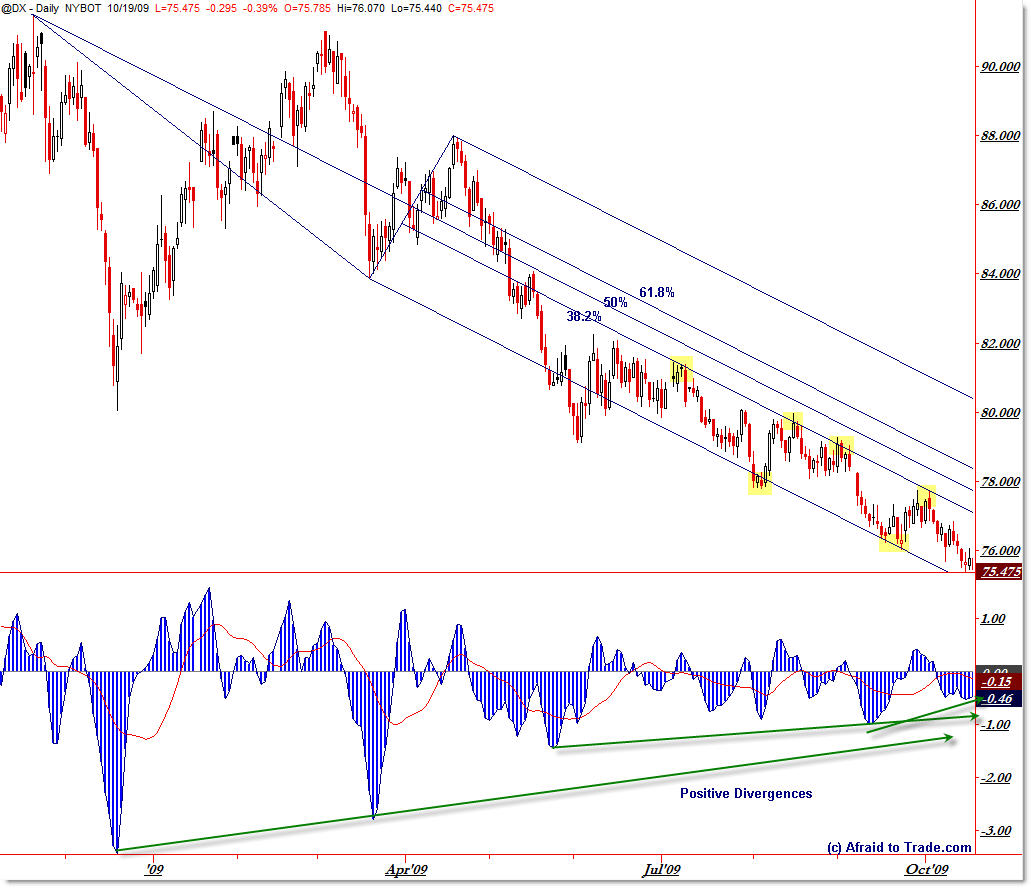Andrews Pitchfork on the US Dollar Index Oct 19
With this morning’s post on the updated Andrew’s Pitchfork tool on the S&P 500, I thought it would also be a good idea to take a look at an Andrews Pitchfork tool of the US Dollar Index (continuous futures contract @DX) for insights. Let’s take a look.

(Click for full-size chart)
Earlier, I took a look at a possible Elliott Wave Count on the US Dollar index, and this time we’ll take another look at pure (index) price using the Andrews Tool in TradeStation.
Starting with the November 2008 price highs and drawing to the March lows then to the April 2009 highs, we see the following “Pitchfork” grid for the Dollar Index.
I have added the 38.2% and 61.8% Fibonacci numbers to the grid which seem to capture the highs (the 38.2% tine line) of the move down.
Andrews Pitchfork charts help unveil hidden structure, especially in lengthy price advances or declines.
Any move upwards above the 38.2% tine line would be bullish and help argue the case for a potential retracement/reversal up, but until then, price continues to move down in the trend between the 0% and 38.2% Andrews lines.
I cheated a little bit and added the 3/10 Oscillator into what otherwise would have been a pure focus on price alone, but it’s important at least to note the multi-swing positive momentum divergence which has been forming under price under each new index low.
The lengthy divergences adds a bullish flair to the otherwise relentless down-trend.
Again, we’ll keep our eye on any positive push up in the Dollar Index, and until then, this remains the dominant Andrews Pitchfork grid for index prices.
Corey Rosenbloom, CMT
Afraid to Trade.com
Follow Corey on Twitter: http://twitter.com/afraidtotrade

E-wave looks like 5 down in the C leg, if you know what I mean.
Hi
a few questions…
I recognize how your chart neatly shows the trend within the 38.2% area of the fork.
However, if the 'handle' of the fork started in 11/08, then why did you by-pass the low of 12/08, and the high of 3/09, for marking your fork tines? This 'first' set of high and low would not have revealed your trend collection of candles.
Likewise if you had selected the 3/09 high as the start of your fork handle, and used your high and low, it would not have revealed your collection of trend in candles.
It seems you have the liberty to select which ever point you desire to start your fork, with any set of high and low you choose; and not necessarily the 'next' set of high and low points. Interesting.
Hey Chomen,
Right – I didn't include the larger fractals, but I did highlight the 5-wave fractal move down in the Elliott Post update I linked to.
Totally agreed!
Hey Reader,
I tried different combination, none of which made any sense (the fork would be too high or too low) so those configurations – as you mentioned – gave no helpful insights into the trend or price structure by using the Pitchfork in a classical/standard manner.
It's often through 'unique' uses or non-conventional uses that you get better results, as shown above (this is a Constance Brown style logic).
You're free to select the points as needed for the Pitchfork – you aren't locked into standard price highs or lows, particularly if they don't make sense.
Sometimes it's trial and error, and sometimes the tool won't work at all.
Your main goal is to see structure, and confine the price in a logical method as best as you can.
If need be, just think of these simply as trendlines instead of a specialized tool.
Got a buy signal on the 3 10 16 MACD
Got a buy signal on the 3 10 16 MACD